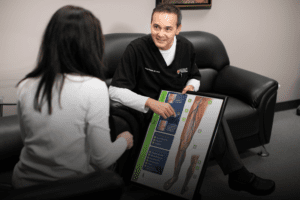If you’ve noticed a network of tiny red and blue veins on the surface of your legs, then you probably have spider veins, a very common ailment experienced by both women and men. As summer draws a little nearer and people start getting excited about outdoor fun and warm-weather clothing, you may feel some hesitation about wearing shorts if you’re dissatisfied with the appearance of the spider veins in your legs. Fortunately, a medical treatment called sclerotherapy is available that can eliminate spider veins and restore your confidence.
Often spider veins are purely cosmetic, but sometimes they are the result of venous insufficiency–a more serious problem that should be addressed first. Spider veins, especially when accompanied by pain, aching, or swelling, may indicate that a vein deeper in the leg has damaged valves. When blood cannot move properly through these deeper channels, the back flow increases pressure elsewhere in the venous network, which manifests visibly as bulging varicose veins or tiny branching red and blue spider veins. At Artemis Vein Center, we use ultrasound to screen patients with spider veins for venous insufficiency in order to make sure there isn’t an underlying cause. If the ultrasound determines that there is a deeper problem vein, then it’s best to start with endovenous laser ablation. This procedure, which is minimally invasive and virtually pain-free, can be carried out in the comfort of our clinic using our state-of-the-art CoolTouch™ laser.
The initial ultrasound may rule out the possibility of deeper problems, which means that the patient’s spider veins are just cosmetic. (Spider veins can also be caused by heredity, sun exposure, hormonal changes, or injuries.) In these cases, or if a patient has already had a problem vein addressed, sclerotherapy can be utilized to reduce or eliminate the appearance of spider veins.
Sclerotherapy is a simple, effective procedure that can also be performed at the vein clinic. Tiny needles are used to inject a sclerosing agent in the spider veins, causing them to collapse and fade. In the past, highly concentrated saline was injected, which could cause cramping and burning, but fortunately we now have new sclerosants that make treatment essentially painless. Approximately one injection is administered for every inch of spider veins that need to be removed. Treatment may take between 30 to 60 minutes to complete, depending on the number of veins and the difficulty of accessing them. Typically, two to three spider vein treatments are required to achieve optimal results.

After treatment, patients can drive home and resume regular activities. Walking is encouraged, but strenuous exercise should be avoided. Compression stockings are prescribed for a short period of time following the procedure. Wearing the stockings is very important because they increase the safety, comfort, and success of the recovery period. Stockings keep the treated vessels compressed, which helps them heal shut and prevents blood from becoming trapped in the veins. Trapped blood in these veins may lead to unnecessary pain, inflammation, darkened pigmentation, and decreased effectiveness of the sclerotherapy. This necessity of wearing compression stockings after the procedure means that winter or early spring is a great time to receive treatment–the stockings can be hidden under pants and won’t interfere with any summer activities.
After the procedure, Tylenol may be taken for any discomfort, but patients should avoid aspirin, ibuprofen, or other anti-inflammatory drugs for at least 48 hours. For seven days after treatment, it is also important to avoid hot baths, hot compresses, direct sun exposure, whirlpools, and saunas. Showers are permitted but the water should be cooler than normal; the injection sites may be washed with a mild soap and tepid water.
In general, patients see the effects of treatment on their spider veins in three to six weeks. Responsive spider veins will not reappear, but it is important to note that sclerotherapy will not prevent the formation of new spider veins.
Sclerotherapy is considered the gold standard for treating spider veins. According to the Mayo Clinic, studies show that as many as 60%-80% of injected veins may be eliminated through sclerotherapy. Less than 10% of patients who have sclerotherapy procedures do not respond to the injections. In these uncommon cases, different solutions can be tried.
If you have spider veins, varicose veins, or are experiencing tiredness, aching, swelling, or pain in your legs, it’s a good idea to schedule an appointment with a phlebologist, a doctor who specializes in the treatment of vein diseases. Though some spider veins are annoying only because of their appearance, it’s important to make sure there isn’t a more serious problem. Left untreated, diseased veins can get progressively worse over time, leading to complications down the road.
Fortunately, there’s no need to be unsure about what your spider veins mean! Contact us at Artemis Vein Center and we will be happy to discuss your symptoms with you and answer any questions you have. If you choose to come in for a screening, we will pay every attention to your comfort and to ensuring that you have a great experience. The thought of undergoing any form of medical treatment can be intimidating, but we encourage you to read the patient success stories and comments on our website to gain insight into how our wonderful and experienced team cares for every patient, and how you can expect us to care for you.